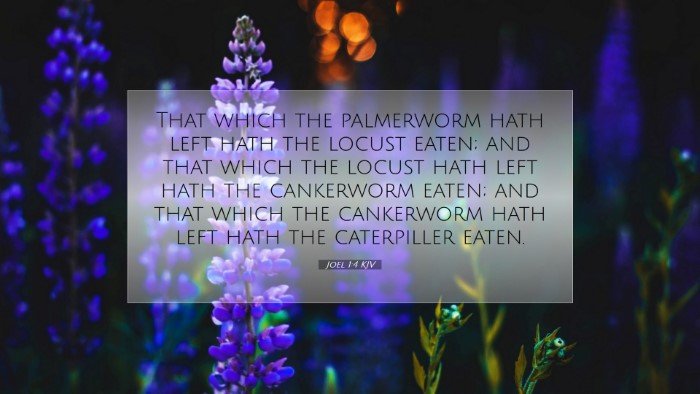Old Testament
Genesis Exodus Leviticus Numbers Deuteronomy Joshua Judges Ruth 1 Samuel 2 Samuel 1 Kings 2 Kings 1 Chronicles 2 Chronicles Ezra Nehemiah Esther Job Psalms Proverbs Ecclesiastes Song of Solomon Isaiah Jeremiah Lamentations Ezekiel Daniel Hosea Joel Amos Obadiah Jonah Micah Nahum Habakkuk Zephaniah Haggai Zechariah MalachiJoel 1:4
Joel 1:4 KJV
That which the palmerworm hath left hath the locust eaten; and that which the locust hath left hath the cankerworm eaten; and that which the cankerworm hath left hath the caterpiller eaten.
Joel 1:4 Bible Commentary
Commentary on Joel 1:4
Verse: "That which the palmerworm hath left hath the locust eaten; and that which the locust hath left hath the cankerworm eaten; and that which the cankerworm hath left hath the caterpillar eaten."
Introduction
This verse from the book of Joel serves as a poignant reminder of the devastation inflicted by pests on the agricultural landscape of Judah. It is within this context of ruin that the prophet expresses the seriousness of the spiritual and physical conditions of the people. The imagery of successive waves of destruction—represented by various insects—powerfully illustrates not only the immediate calamity but also signifies a deeper spiritual decay.
Historical Context
The book of Joel is typically dated to the post-exilic period, a time when Israel was grappling with the remnants of its past and the call to repentance. The devastating invasion of locusts, described in this chapter, can be understood as both a literal event and a figurative indication of looming judgment due to the nation's sins. Each pest represents layers of judgment, implying that the people have not only suffered from loss but have also failed to heed the warnings of God regarding their spiritual state.
Meaning of the Verse
This verse employs a series of pests to convey the idea of complete devastation. Each insect mentioned—the palmerworm, locust, cankerworm, and caterpillar—denotes a progression of destruction:
- Palmerworm: Translating to "gnawer," this insect signifies the initial stage of consumption, which initiates the cycle of loss.
- Locust: Known for their swarming behavior, these insects are often viewed as agents of widespread devastation, emphasizing the communal aspect of suffering.
- Cankerworm: A metaphor for gradual decay, this pest represents the lingering effects of sin over time.
- Caterpillar: Finalizes the imagery of complete consumption, indicating that nothing is left untouched by judgment.
Theological Implications
Theologically, Joel 1:4 serves not only as a narrative of present calamity but as a warning of divine judgment on a nation that has strayed. This multifaceted destruction points towards a holistic view of sin's consequences—both physical and spiritual.
Insights from Commentaries
Matthew Henry
Matthew Henry emphasizes the severity of the locust plague as a visible sign of God's displeasure against Judah's disobedience. He interprets the repetitious nature of the pests as indicative of the judicial decrees of God, wherein each subsequent worm represents the escalation of divine punishment for the nation’s transgressions. Henry notes the importance of repentance and the acknowledgment of one's sins as a way to avert further destruction.
Albert Barnes
Albert Barnes discusses the physical representation of God's judgment through these insects, pointing out that they serve to indicate both the tangible and intangible losses suffered by the people. The passage encourages the audience to recognize sin's impact, where spiritual drought parallels physical deprivation. Barnes stresses the need for communal repentance as a necessary step toward healing.
Adam Clarke
Adam Clarke's commentary notes the literal understanding of this verse as relating to agricultural failure. Clarke underscores that such devastation is often a precursor to moral and spiritual decay among the people. He likens the insects to spiritual adversaries that consume the vitality of the people when they stray from their covenant with God. Clarke concludes with a pastoral call for the leaders to awaken a sense of urgency for national repentance.
Application for Contemporary Readers
For modern pastors, students, and theologians, Joel 1:4 can serve as a metaphorical lesson about the cumulative consequences of sin. Every act of neglect in one area leads to further degradation in another, a principle that can apply both to personal lives and communal faith positions. The imagery of consumption invites reflection on what aspects of one’s spiritual life may be under threat, and urges a collective turning back to God:
- Recognition of Sin: Individuals and churches must recognize the destructive patterns that can lead to spiritual starvation.
- Call for Repentance: Just as Joel calls for mourning and repentance, contemporary churches must foster environments where confession and renewal are encouraged.
- Acknowledgment of God's Sovereignty: Understanding this passage in light of God's control over nature and history fosters a deeper faith in divine providence amidst calamity.
Conclusion
Joel 1:4 functions both as a cautionary tale and an urgent call to action for contemporary believers. By reflecting on the devastation that occurs without spiritual vigilance, individuals and congregations can better align themselves with God's will, ensuring that they do not fall prey to the consuming forces of sin, but instead cultivate a life of faith and obedience.


